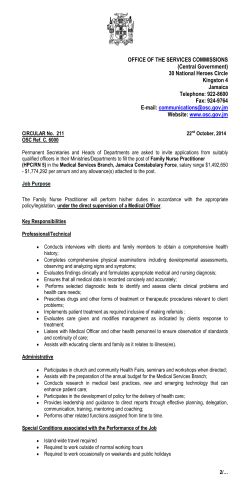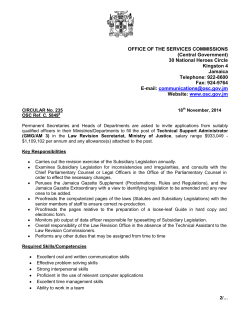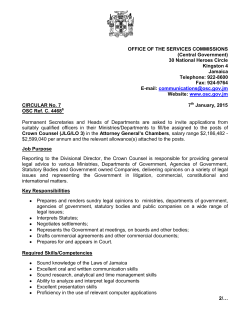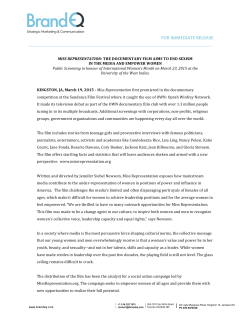
Jamaica
The Use of Geospatial Data to address the Unique Vulnerabilities of Caribbean SIDS THE CASE OF JAMAICA, W.I. Presenter: Nadine Brown UN-GGIM Side Event - Unleashing the power of ‘Where…’ April 22,2015 United Nations Headquarters, New York PRESENTATION OUTLINE Jamaica Sustainable Development Needs and Vulnerabilities Vision 2030 Jamaica National Development Plan Examples of How Geospatial Data is being used to address vulnerabilities Conclusion SIDS Sustainable Development Needs and Issues • • • • • Small Size Fragile economies Heavy dependence on fossil fuels Exposure to natural disasters Exposure to the impacts of climate change Environmental Vulnerabilities often Influence Economic Vulnerabilities Jamaica Total impact of natural disasters on Jamaica’s economy - 2.0 % of total GDP between 2001 and 2012. VISION 2030 JAMAICA - NATIONAL DEVELOPMENT PLAN Hazard Risk Reduction and Adaptation to Climate Change Sustainable Management and use of Environmental and Natural Resources GOAL 2 The Jamaican society is secure, cohesive and just GOAL 4 Jamaica has a healthy natural environment Sustainable Urban and Rural Development GOAL 1 Jamaicans are empowered to achieve their full potential GOAL 3 Jamaica’s economy is prosperous Outcome 11 – make available and accessible geospatial data, products and services to all users, to facilitate planning, sustainable use, management and development of the island’s resources State of the Jamaican Climate Source: Climate Studies Group, Mona (CSGM), 2012: State of the Jamaican Climate 2012: Information for Resilience Building (Full Report). Produced for the Planning Institute of Jamaica (PIOJ), Kingston Jamaica. Near Term Climate Scenarios - generated at the scale of the watershed - for wind, temperature and precipitation - Impact on key sectors – Tourism, Agriculture, water Source: Climate Studies Group, Mona (CSGM), 2014: Near-Term Climate Scenarios for Jamaica (Technical Report). Produced for the Planning Institute of Jamaica (PIOJ), Kingston Jamaica. Jamaica –Near Term Climate Scenarios JAMAICA AT PRESENT Mean temperature increases by 1.3 oC by 2020s. Decrease in annual rainfall If sea level rises by 0.18m the predicted loss of land area is 101.9 km2 and 416.4 km2 for a 10 m increase. Areas forecasted to be inundated are fast growing urban areas Source: Robinson, Rowe, Khan, (2005) Linking Ecosystems to Risk and Vulnerability Reduction Source: Risk and Vulnerability Assessment Methodology Development Project (RiVAMP) Linking Ecosystems to Risk and Vulnerability Reduction The Case of Jamaica Results of the Pilot Assessment UNEP,PIOJ (2010) Exposure of assets to Flooding 10 YEAR RETURN PERIOD STORM 50 YEAR RETURN PERIOD STORM Source: Risk and Vulnerability Assessment Methodology Development Project (RiVAMP) Linking Ecosystems to Risk and Vulnerability Reduction The Case of Jamaica Results of the Pilot Assessment UNEP,PIOJ (2010) Coastal Multi-Hazard Mapping and Vulnerability Assessments LAND USE CHANGE ASSESSMENT CONCLUSION Geospatial data is critical to contribute to evidence-based decision making in addressing the unique vulnerabilities of SIDS Because of its ability to combine and analyse a multiplicity of data GIS and related technologies are useful tools for monitoring and reporting on Post 2015 SDGs;’ While geospatial data may be useful to monitor and report on progress towards achieving SDG, many SIDS lack the human and institutional capacity required to do so. Vision 2030 - “Jamaica, the place of choice to live, work, raise families and do business”
© Copyright 2025













